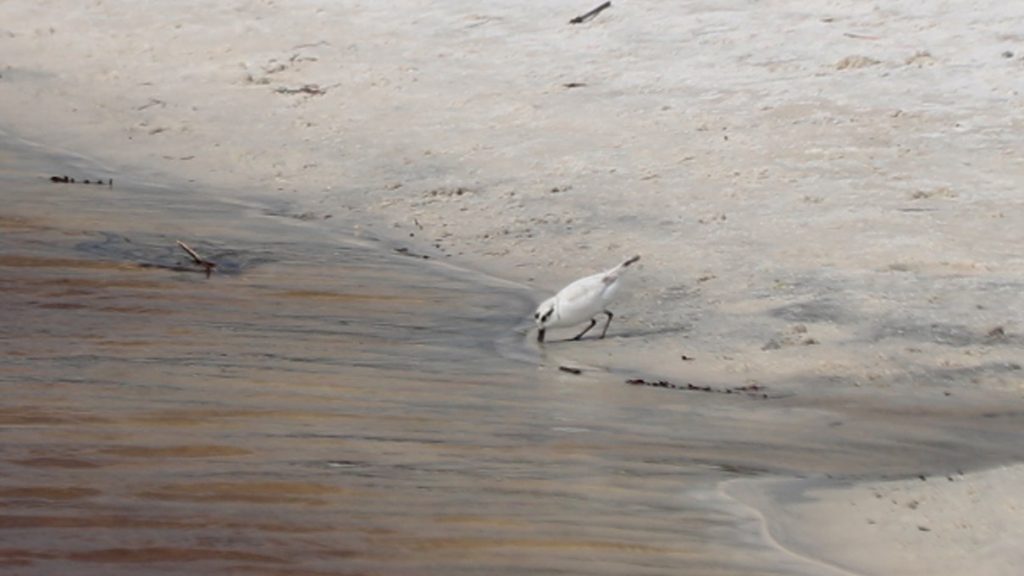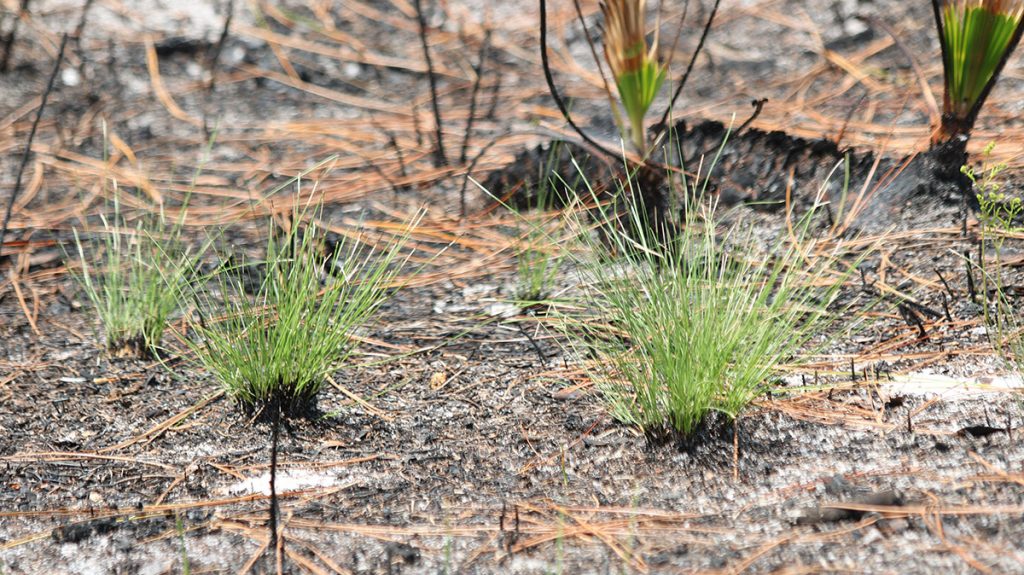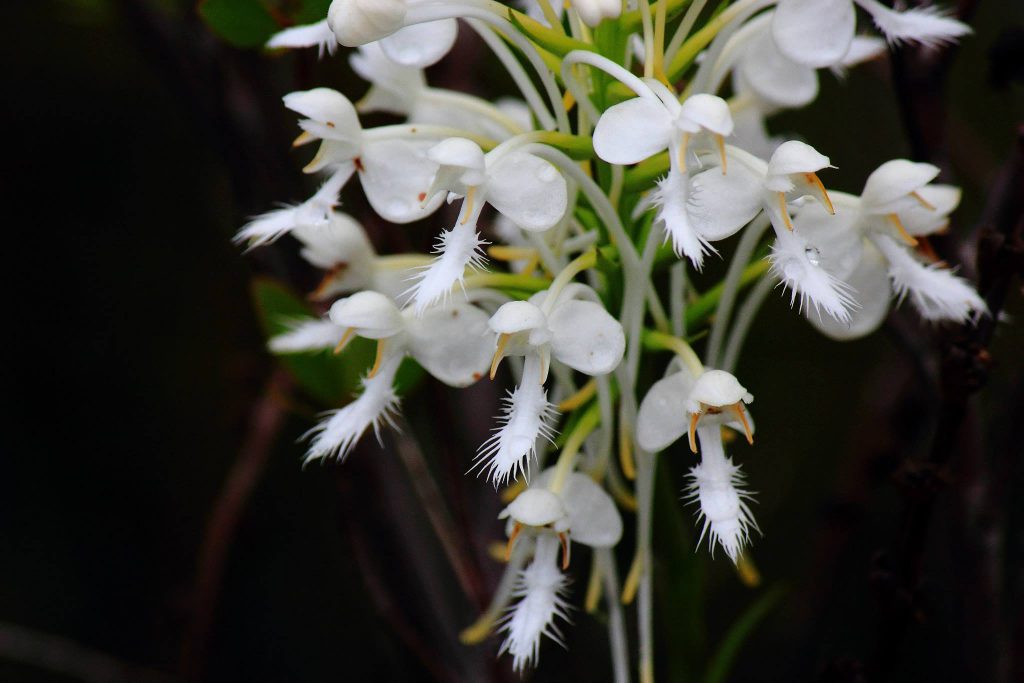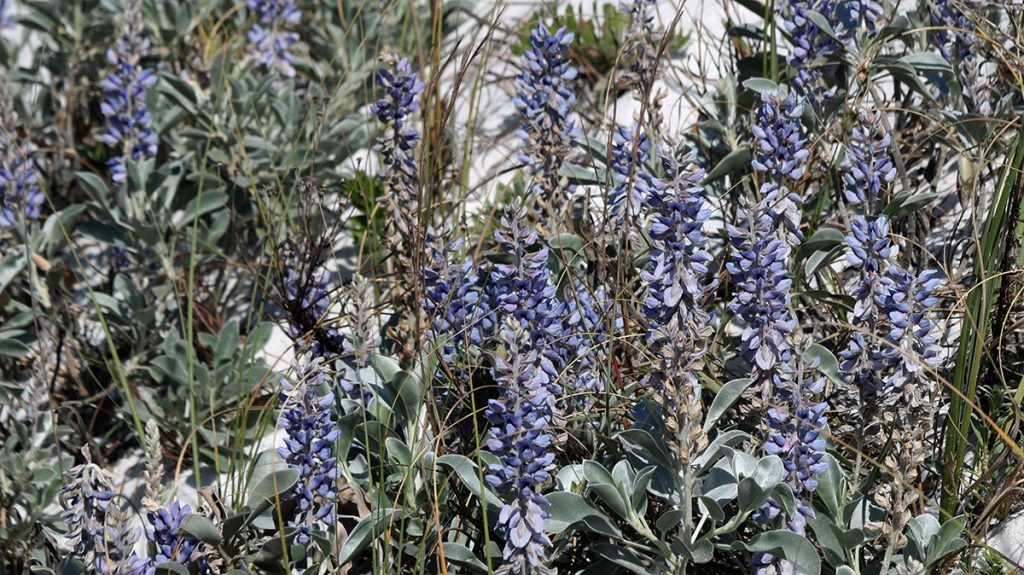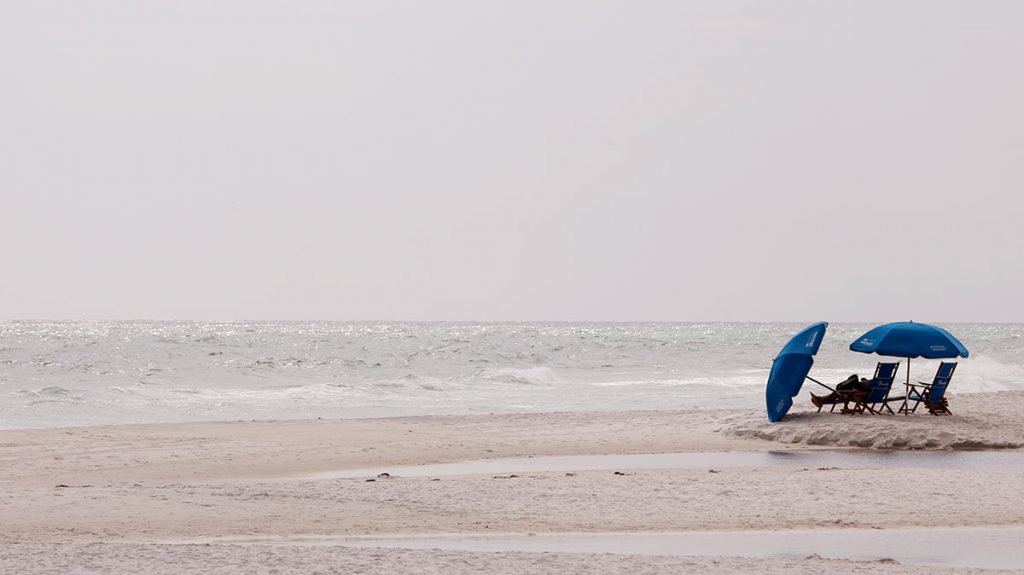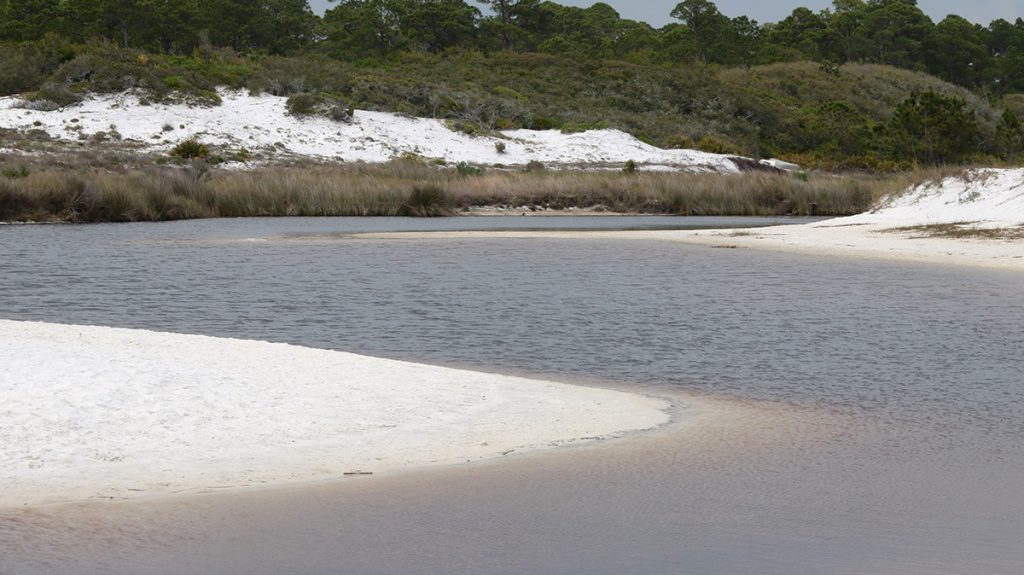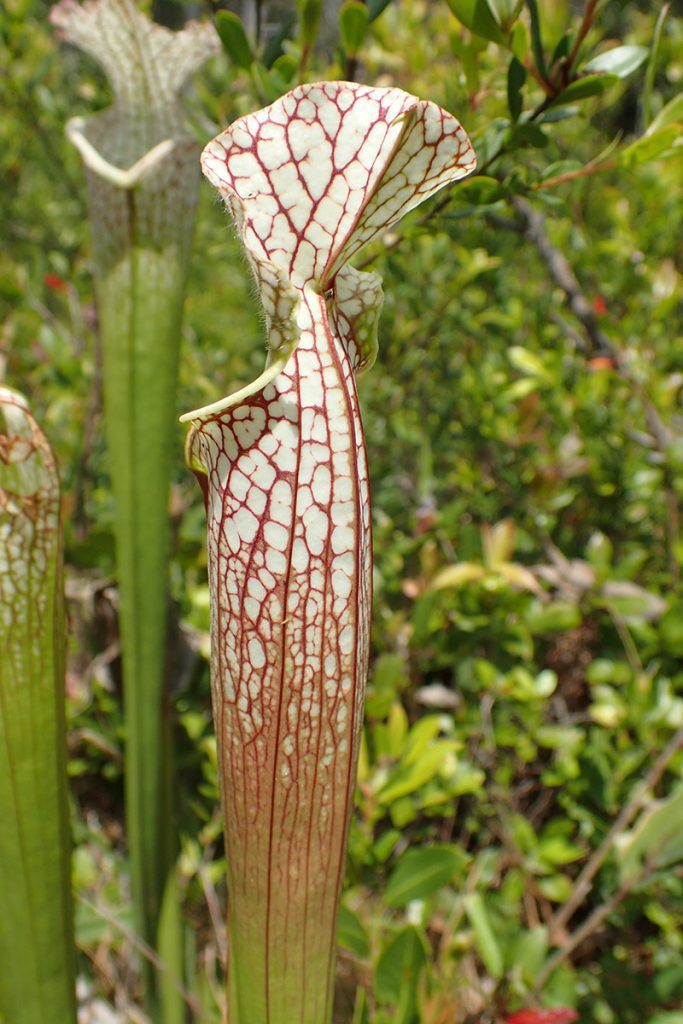Over the last year, we’ve explored many aspects of fire ecology. Today, we see how fire helps water move through the coastal dune lake watershed, connecting pitcher plants and nesting shore birds.
Rob Diaz de Villegas WFSU Media
The snowy plover, sitting on its nest by the coast, is connected to the pitcher plant growing by the upland forest. We’re at Deer Lake State Park in Walton County, Florida, tracing this bond through a coastal dune lake watershed. Water, of course, unifies this system. But for that water to move through the system how it should, it needs fire.
We’re with John Bente and Jeff Talbert of the Atlanta Botanical Garden. The ABG has partnered with the Florida Park Service on a project aimed at benefitting snowy plover nesting sites. These shore birds favor estuarine habitats, in which there is a mix of salt and fresh water. That mix is dependent on the movement of water through the uplands on down to coast. The movement of water is, in turn, affected by the state of the habitats through which it flows.
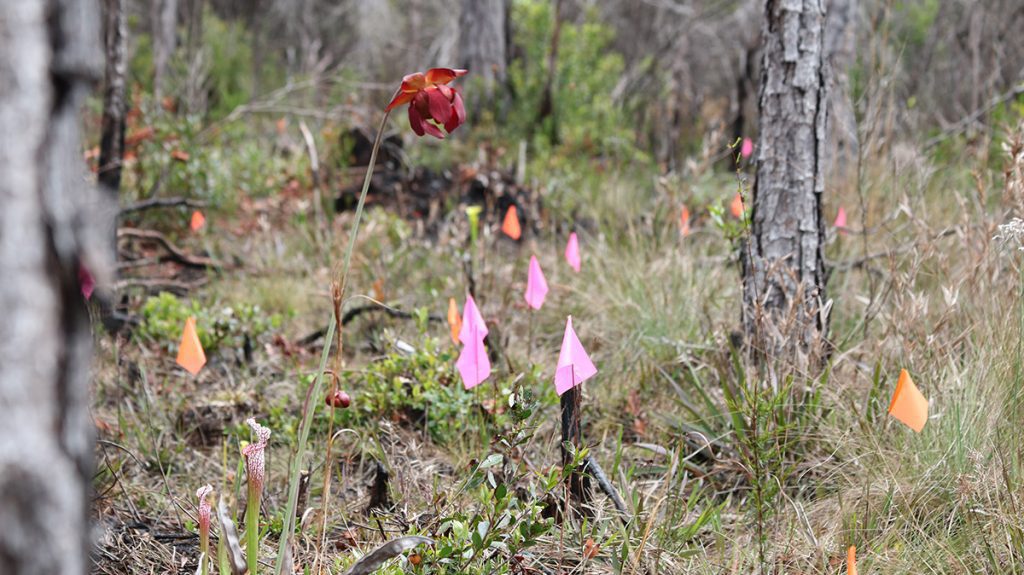
Colored flags mark where carnivorous plants were reintroduced into a recently cleared remnant prairie. In the lower left, you can see white topped pitcher plants; the tall flower is from a purple pitcher plant.
And that’s why we’re walking through a bog full of little colored flags. Each flag is next to a carnivorous flower planted by the ABG. Behind us, a work crew is tearing through a wall of titi, returning this land to its previous openness. And in the ecology of the American southeast, openness is often associated with fire.
“We’re trying to introduce fire back into these areas that have been cleared that haven’t had fire in as much as 70 or 80 years.” Jeff tells us.
“One of the problems is,” John says, “is that most of areas in the whole panhandle of Florida have degraded because most of the pine lands went through this period of fire exclusion.” Many of the forests we visit are undergoing this rebuilding process, which gives us ample opportunity to look at the importance of fire in our ecosystems. Not many of these efforts are funded to help our coasts, however.
The Deer Lake State Park Restoration Project
The restoration work being done in Deer Lake State Park is a collaboration between the Florida Park Service and the Atlanta Botanical Garden. Using aerial photographs from 1941, the Park Service noticed that the upland areas of the park had previously been much more open. In the decades since, fire had been excluded and hardwood trees had grown tall and shaded out the herbaceous ground cover in these areas. The park’s upland ecology needed to be repaired.
“We started thinking about doing this project in 1996,” John Bente recalls. After that, they spent many years “working on a shoestring with little headway.”
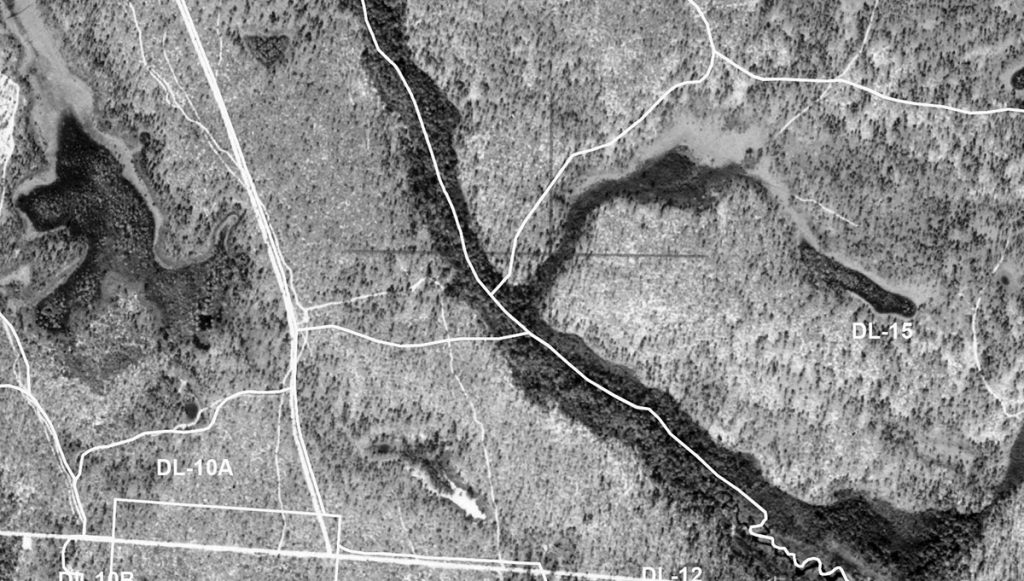
An aerial photo of the area surrounding Camp Creek. The dark areas are dense with trees, and in the grey open areas, you can make out individual trees. This open habitat became overgrown and woodier as fire was excluded from the landscape.
That changed in the aftermath of the 2010 BP oil spill. Florida didn’t suffer damage as extensive as that in other Gulf states; however, the ecology of the Gulf as a whole was badly impaired. BP ended up paying $18.7 billion in fines, $2.5 billion of which was given to the National Fish and Wildlife Foundation to fund restoration efforts in affected states.
Through the NFWF’s Gulf Environmental Benefit Fund, the Florida Park Service received funds to improve nesting habitat for snowy plovers, a species of shorebird harshly impacted by the spill. Snowy plovers nest in estuary ecosystems where fresh and salt water mix.
When looking at the health of a coastal ecosystem, you’re looking at the health of every waterway that feeds it. You’re also looking at the health of every ecosystem through which water drains into the watershed. With their NFWF funding, the Park Service would finally restore pine uplands and pitcher plant bogs in Deer Lake. Their efforts give us an opportunity to see how the components of a watershed work together to move water to the coast. They also give us a glimpse into how fire benefits a globally rare ecosystem.
The Coastal Dune Lake Watershed
Coastal dune lakes receive water from rain and runoff. Not all of the rain that lands in the uplands will flow to the dune lake. But if the system is properly maintained, a good amount will make it in and when the lake level gets high enough, it will break through a berm of sand on the beach and into the Gulf of Mexico.
In some ways, a coastal dune lake functions much like a river. It needs a certain amount of fresh water input to maintain estuary habitats where it meets the coast. We’ve seen how the Apalachicola River’s estuaries have been adversely affected by drought and low flows. Coastal dune lakes aren’t continuously connected to the Gulf, however. And their irregular connection with salt water means that any individual lake’s chemical composition can change over time.
But while the way in which it mixes with salt water is different, it receives freshwater in much the same way as many rivers. The amount and quality of that water is critical to the lake’s ecology. As it turns out, both the quantity and quality of water entering the lake are dependent on fire.
The Coastal Dune Lake Watershed Tour
1a. Healthy Pine Uplands Maintained with Fire
I’m standing in a recently burned forest. The uplands in Deer Lake State Park were once owned, as was a lot of forest land in north Florida, by the St. Joe Company. Like much of that forest land, it had been clear cut of its native longleaf pine within the last 100 years and replanted with slash pine. Where the longleaf naturally grew into a wide spacing, the slash was planted closer together to yield more timber. The trunks are skinny, as the trees are young for a species that can live for hundreds of years.
It’s not a perfect example of a pine upland community, but the trunks are black and the ground is bare. It is regularly burned, and grasses and palmettos are already growing back after the fire. It’s a healthy ecosystem.
Like much of the pine uplands in Florida, this is a sandhills habitat. Sand is a nutrient poor soil type, and regular burning keeps any organic matter from gathering and decomposing on the sand. The pine needles themselves are a fuel for fire, and wiregrass will brown and dry out at roughly the same interval at which fire would naturally occur (between 2-5 years). The uncluttered, sandy soil is important in maintaining a regular movement of water downhill.
“All the soils are highly permeable,” says John Bente. “Rainfall soaks into the sandhill, and then is percolating downslope.”
1b. Pine Uplands Choked with Titi
The upland pine communities of the American southeast area filled with grasses and succulent plants that thrive with regular burning. As we’ve previously covered, it’s one of our country’s most diverse ecosystems. Hardwood trees such as oaks and titi naturally occur in pine sandhills, though regular fire checks their growth, making them shrublike.
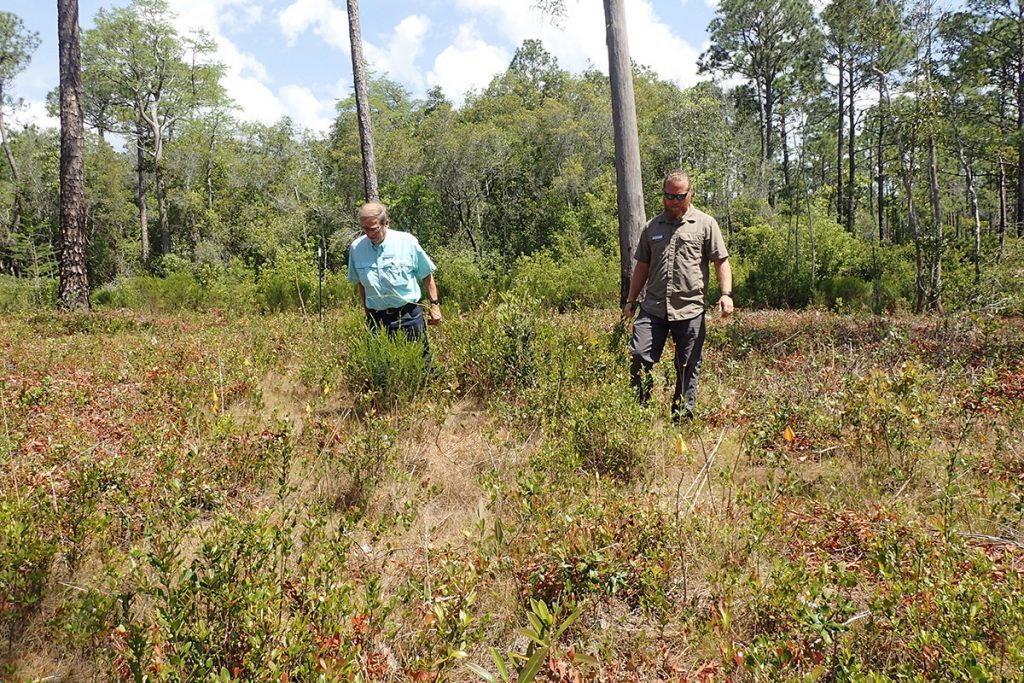
John Bente (Left) and Jeff Talbert (right) walk through titi shrubs in search of orchids and carnivorous plants. In an uncleared parcel behind them, black titi has grown tall.
When fire is excluded, as it had been in Deer Lake, hardwoods take over. The recently burned forest where we’re standing overlooks a section of woods choked with 30 foot titi trees. The hardwoods outcompete the grasses and other ground cover plants in this ecosystem. They also change the way water flows downhill.
For one, they drop leaves on the ground. The leaves decompose and add duff, or humus, to the soil. Sandills are a nutrient poor ecosystem, and these decomposing leaves add nutrients to the system and makes the soil less permeable. A nutrient rich environment favors a different set of plants than had naturally grown there.
There is another problem with the forest becoming dense with 30 foot titi trees. “Another thing that happens in this sort of forest of titi is, a lot of the water that would be percolating out, hitting this stream, and moving towards the Gulf of Mexico, is actually absorbed by the roots of the titi and it’s transpired right back into the atmosphere.” John says. “So we actually lose a lot of water from this.”
Unfortunately, you can’t just reintroduce fire to a titi choked forest. Because the trees had become so thick, the only way to clear them is to chop them down. Their plan is to clear at least 110 of 330 acres of degraded forest by 2020, the end of their current funding.
2. The Wet Prairie
Just downslope of the pine forest, the land is open. There are about as many titi plants in this prairie as there are in the uncleared forest, but they are only a couple of feet tall. We take a walk among these shrubs, and are treated to the most visually pleasing part of this restoration.
We see pitcher plants, sundews, and butterworts- carnivorous plants that thrive in the nutrient poor fringes of the pine woods. It’s May, and many of these are in bloom. There are also orchids; the rose pogonia, or snake mouth orchid, is currently in bloom (seen in the banner image above).
At another bog site, we see hundreds of little colored flags on recently scorched ground. In the background, a work crew feeds titi into a wood chipper. The Atlanta Botanical Garden has been collecting seed from local flowers to breed. In March of 2017, volunteers from the Jacksonville Zoo and Garden (which plays a large role in another sandhills related project we’ve covered) planted 1631 pitcher plants and over 900 white fringed orchids.
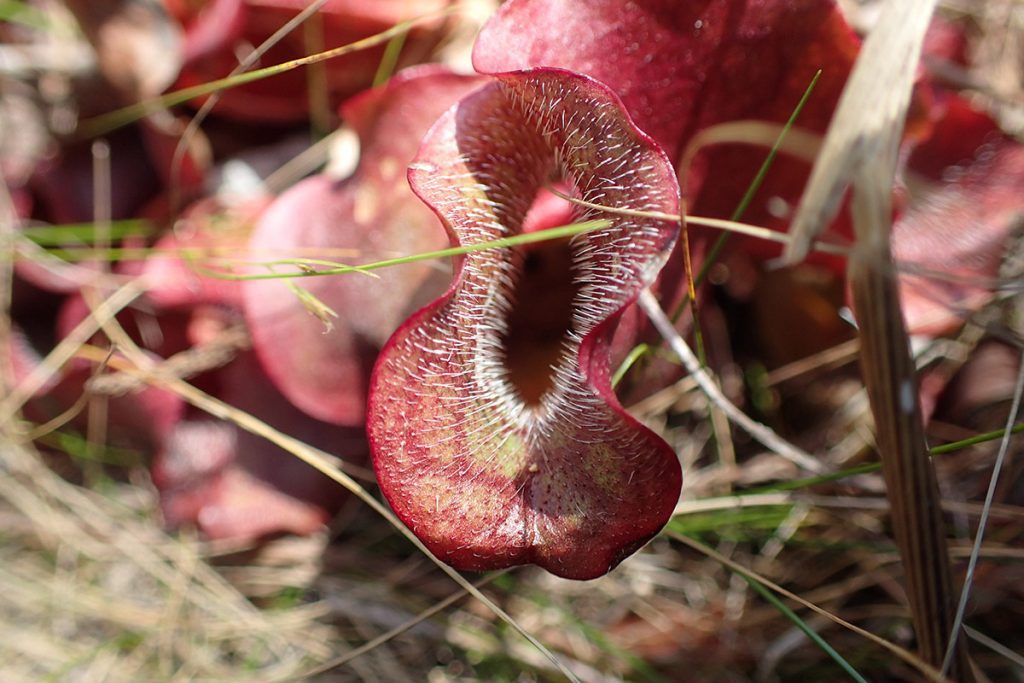
Purple pitcher plant. Note the hairs facing into the pitcher, which impede an insect trying to make its way out. Carnivorous plants grow in nutrient poor soils, and receive needed nutrients from insects.
The 1941 aerial photos showed that creeks feeding costal dune lakes were often surrounded by wet prairie habitat. Records kept by the State Park Service showed that the habitat was open and herbaceous, and full of these types of flowers associated with the fringes of the uplands. While these bogs often hold water, they also burn often enough to limit the growth of titi. A healthy prairie ecosystem is a critical link in the movement of water towards the lake.
3. Camp Creek
Deer Lake State Park is named after the coastal dune lake entirely contained within its boundaries. In the uplands where we are, however, runs Camp Creek, a primary source of water for Camp Creek Lake. A small feeder creek from this system runs by the first bog we visited. On the opposite side of this small trickle lies a recently cleared space; you can see a few sawed off stumps sticking out of the black earth there. One day, that side of the creek will look more like the prairie we explored.
Fire in the uplands and the surrounding prairie leaves an open path full of less thirsty plants than had been there previously. Water now drains more freely into this system to make its way to the lake.
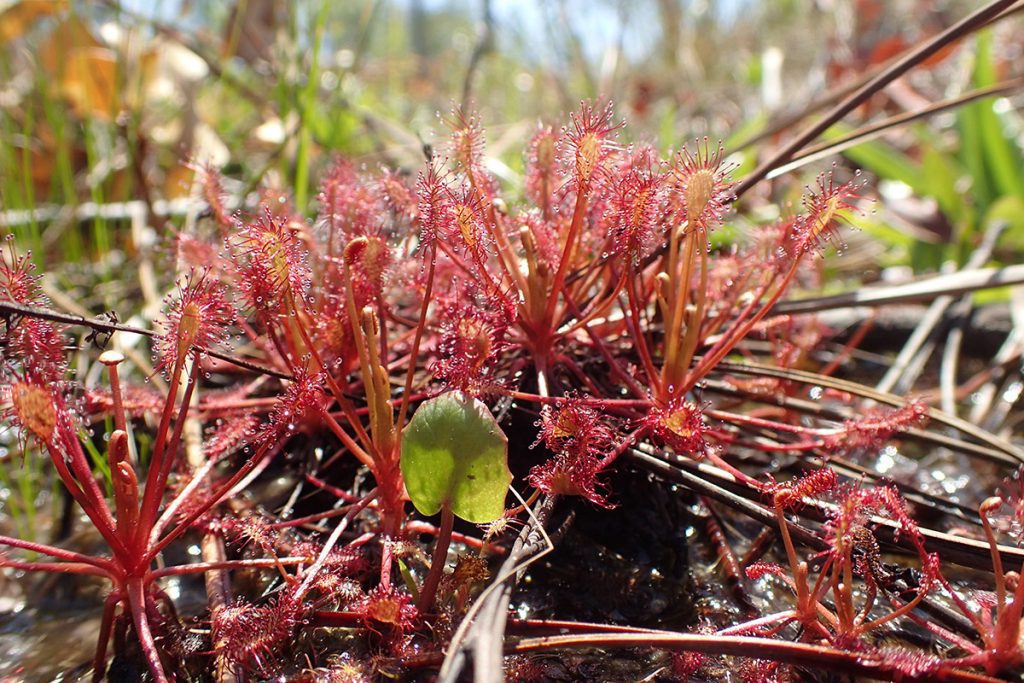
Oblong leaved sundew growing along the bank of a small creek feeding Camp Creek. The plant ensnares insects in the musilage (the drops of liquid) at the end of its tentacled glands.
4. Camp Creek Lake
We interview John Bente and Jeff Talbert on the shore of Camp Creek Lake. Unlike Deer Lake, Camp Creek Lake is only partially protected by public land. The many homes along the water, and adjacent to the pine woods, are a cause for caution.
“It can be a challenge,” Jeff says, ” especially when you’re trying to do a prescribed burn. There are houses right up next to the edge of these protected lands… you can’t put smoke on the road, you can’t put smoke on people’s houses.” This means they’re limited to burning small parcels of land, and have to keep a close eye on wind and weather projections.
Here at the northern edge of the lake, we see the kind of marsh grasses typical of the brackish end of an estuary system. Water has traveled down Camp Creek, and when the lake is full enough, it will touch the Gulf.
5. The Deer Lake Outfall
We’re presently unloading our gear at the Deer Lake State Park parking area. We start down a boardwalk that takes you down a few hundred feet of sand dunes. One or two of the dunes has eroded away, revealing the roots of a living tree around which the dune has accumulated. Purple gulf coast lupine lines the last dune.
Down the beach a ways, we see what looks like a winding tidal pool. A little girl and her father probe around it with a clamming shovel. Here, Deer Lake lies just a couple dozen feet from the Gulf of Mexico.
Turning back the other way, we see the lake snake its way through dunes, and alongside a condominium building. The dunes on the State Park side are roped off with warnings to not disturb nesting shore birds. On the shore along these dunes, a single snowy plover pecks at the sand.
In just a few hours, we’ve seen a lot of this watershed. We’ve seen forests and bogs in various states of repair, from degraded forest choked with titi to recently cleared prairie to the recently burned forest sprouting new wiregrass. Like with any of the restoration projects we’ve visited recently, I’m looking forward to seeing the place in a few years. Since the project started, they’ve already seen a big difference.
“(It’s) extremely satisfying to know that work that is going on here is advancing and making these areas better.” Says Jeff. “I mean, to watch new plants come up… every growing season, or to watch flowers, and see them where you’ve never seen them before- it’s wonderful. It’s very satisfying.”
Species Seen in the Video
0:06 Hat pins (Eriocaulon decangulare), also known as bog buttons, growing alongside Camp Creek Lake.
0:08 Oblong leaved sundew (Drosera intermedia)
0:14 Three white topped pitcher plants (Sarracenia leucophylla) at the center of the frame, with a purple pitcher plant (Sarracenia purpurea) flower to the left of them.
0:36 Purple pitcher plant (Sarracenia purpurea) flower.
0:41 Snowy plover (Charadrius nivosus) foraging along the outfall of Deer Lake.
1:29 A thicket of hardwood trees, predominantly black titi (Clifton monophylla).
1:38 Black titi in shrub form.
1:46 Parrot pitcher plant (Sarracenia psittacina)
1:49 White topped pitcher plants, one with fly at the pitcher opening.
1:51 Yellow butterwort (Pinguicula lutea).
1:53 Oblong leaved sundew.
1:54 Rose pogonia (Pogonia ophioglossiodes), also known as snake mouthed orchid, being pollinated by a wasp.
2:02 Purple pitcher plant.
2:05 Several purple pitcher plants mixed in with wiregrass (Aristida stricta).
2:09 Several recently burned slash opine (Pinus elliottii).
2:25 Snowy plover.
2:31 White topped pitcher plant with fly at the pitcher opening.
2:51 Snowy Plover.
3:03 Wiregrass growing back after a recent burn. The singed tips were all that were left aboveground after a burn a couple of weeks earlier, the rest is what has grown since.
4:04 Rose pogonia (left) with purple pitcher plants.
4:42 Parrot pitcher plants in a thicket of titi. Despite this area having grown thick from fire exclusion, some pitcher plants remain from when the area was an open prairie.
4:47 Small, recently planted white topped pitcher plants, lower left. Purple pitcher plant flower, center.
5:16 Purple pitcher plant flower.
5:19 White fringed orchid (Platanthera blephariglottis).
5:43 Tracy’s sundew (Drosera tracyi), or dew thread sundew.
5:46 Purple pitcher plant flower.
5:51 Dew thread sundew about to bloom.
5:54 Purple pitcher plant.

